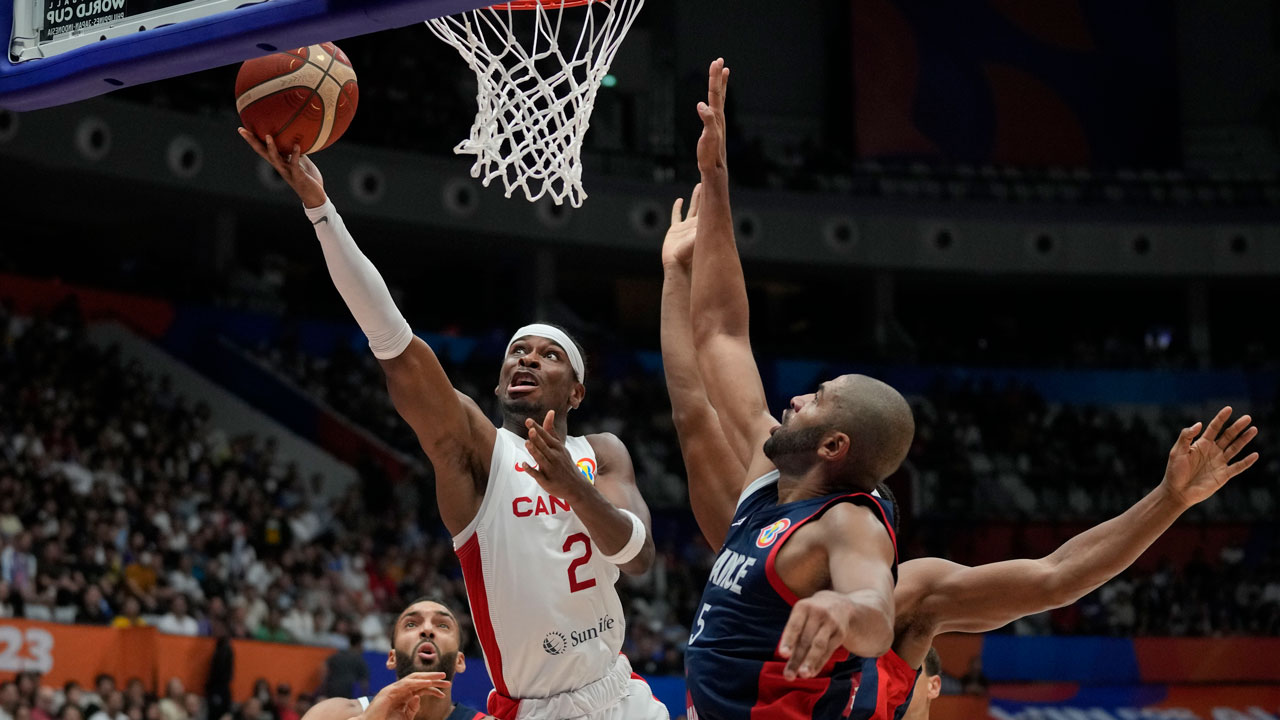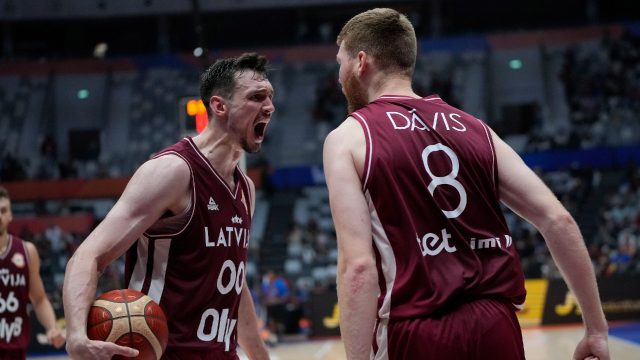
So, you’ve defeated Luka Doncic.
The FIBA World Cup allows no room for “easier” matchups at this stage, yet perhaps you feel like, at least, you’ve gotten past the largest individual player hurdle you’ll face on your way to the podium.
Ha!
Tremendous and heliocentric as Doncic is, and while he’s appeared and will continue to appear on NBA Most Valuable Player ballots for years, there is a challenge still ahead who has an even greater claim as “The Best FIBA Player In The World,” and his name is Bogdan Bogdanovic.
At this level, in this event, surrounded by this Serbian team, Bogdanovic might be international basketball’s superboss on the way to the final boss that is (presumed to be) the United States.
Canada will play Bogdanovic and Serbia on Friday morning (4:45 a.m. ET / 1:45 a.m. PT on Sportsnet) in the semifinals of the FIBA World Cup. Let’s take a look at how they stack up.
How they got here: Canada
Hopefully, you’ve been paying attention to Canada’s historic run all along. If you haven’t, welcome. They finally did it, delivering on all of the talent and promise they’ve shown for decades. They’ve qualified for the 2024 Paris Olympics, and for the first time in the history of the men’s program, Canada is in a World Cup semifinal.
It’s a really big deal.
Canada’s been imperfect on their path here. Almost everyone has been; it’s an extremely difficult tournament.
What started as an awe-inspiring blowout-fest in the first round quickly turned dire when Canada was on the wrong end of an upset to Brazil to start the second round. Was that the other shoe dropping, or was the loss an uncharacteristic blip where Canada’s top players played poorly and they struggled to adjust in terms of tactics and lineups?
They answered quickly, pulling out a historic fourth-quarter comeback in a must-win game to defeat Spain and make the quarters.
On Wednesday, Canada dealt with an unseasonably warm outside shooting half from Slovenia before eventually pulling away in victory. The Canadians frustrated Doncic with physicality and strong individual defence, eventually leading to Doncic (and Dillon Brooks) being ejected (separately, somehow). What was believed to be the highest-upside defence in the tournament delivered on that promise, and Gilgeous-Alexander submitted another one for the classics vault.
How they got here: Serbia
With the exception of Germany, no team has looked as consistently and thoroughly strong as Serbia. The Serbians absolutely picked apart a very good Dominican Republic team in the second round after sweeping the first round with a trio of blowouts.
A somewhat strange loss to Italy, though, stood as a red herring — had Serbia had an easier slate of opponents, or just a bad night?
The routing of the D.R. assuaged some doubt, but there was a chance a better Lithuania team that was more capable of adjusting schemes would put them to the test.
Admittedly, I bit on that pump-fake, thinking Lithuania had the size to match up and enough good, young guard play to hang in the game from outside. Wrong. Lithuania did Serbia a favour with some odd lineup decisions and Serbia took full advantage, running away with the game by the end of the third quarter.
Maybe Lithuania would have been a tougher matchup for Canada and the U.S.; it’s likelier Serbia is just very, very good.
The Serbians are a top-three team in the 32-team field in most relevant statistical categories. A two-point loss that still, upon rewatch, doesn’t make a lot of sense stands out as their only real blemish.
Bogdanovic is a FIBA maestro
Throughout those six games, Bogdanovic made the best case that he, not Doncic or Gilgeous-Alexander, is the best player in this environment.
For fans of the FIBA game, this isn’t breaking news. Bogdanovic is incredibly decorated at the international level, playing for silver-medal winning Serbian teams at the 2014 World Cup, 2016 Olympics and 2017 EuroBasket tournaments. He also led the 2019 World Cup tournament in scoring, earning All-Tournament honours. He even recently became just the sixth player in the 21st century to amass 400 career World Cup points.
Not that he’d care about that — the Serbian program is built on team-first basketball and a willingness to suppress the individual for the team.
This isn’t a knock at Doncic, but Serbia is much more adept to succeed if, say, Bogdanovic gets taken out of the offence. Bogdanovic, who was elevated to team captain for this event, has humbly downplayed his own impact or his halftime speeches to teammates.
Don’t let the humility fool you, though. Bogdanovic is headed for another All-Tournament nod, and there are few players in this event as comfortable scoring at all three levels, even against significant defensive attention.
And hey, if you take his scoring game away, he’s also a handsy ball-hawk on defence and one of Serbia’s best screeners.
Other key Serbian players
Nikola Milutinov is one of the best big men in the field and has been one of the best centres in the European game for a decade. He’s a two-time EuroLeague rebounding champion, a former All-Europe centre and a former first-round pick of the San Antonio Spurs.
He’s the anchor for Serbia’s defensive rebounding approach, ranking fifth in the tournament with 9.9 per game in an average of just 26.7 minutes. Most notably, Serbia has a monster plus-14 mark per game with its seven-footer on the floor.
You might recognize the name Nikola Jovic from the Miami Heat. He’s a solid piece. It’s Stefan Jovic, though, who poses the biggest challenge. Not only can he get red-hot from beyond the arc, he’s among the tournament leaders with 6.7 assists per game, and only South Sudan’s Carlik Jones has a better assist-to-turnover ratio.
Teammate Marko Guduric spent most of his post-game media availability this week raving about Jovic and how he misses watching him in EuroLeague. He’s a blast to watch.
Filip Petrusev is the other NBA-notable name, as he’s an NBA-bound prospect with the Philadelphia 76ers. He’s coming off an excellent showing against Lithuania where he helped Milutinov hold off Jonas Valanciunas and Donatas Motiejunas.
And while his numbers were inflated some by a few meaningless late-game threes, he’s legitimate. He was also playing at less than 100 per cent earlier in the World Cup, so it’s possible better games are still ahead.
Borisa Simanic will remain sidelined for Serbia, as he had to have a kidney removed after taking an accidental elbow from Nuni Omot of South Sudan. Bogdanovic has credited him with remaining an inspiring force around the team.
Serbia’s other strengths … and weaknesses
Remember how we teed up the Slovenia game by pointing out how much size the team had, and how the Slovenians don’t play anyone small in their rotation at all? Well, dear editor, please just copy and paste that here, because teeny tiny Aleksa Avramovic — all six-foot-four of him — is Serbia’s shortest player, and he remains a menace at generating steals.
This team is big everywhere.
You might think a team like that wants to slow things down and operate through the post a lot. The Serbians are capable of that, and they may look at Slovenia’s ability to generate big-small post mismatches on Doncic switches and look to create some of the same opportunities.
Canada has proven comfortable going a bit smaller one-through-four for switchability, (and/or using Kyle Alexander for defensive versatility). If the Canadians do that again, Serbia is similarly comfortable switching gears, though its base offence is already a pretty strong mismatch-creator.
Generally, this is a Serbian team all about ball movement to scatter a defence and open up the paint. It runs a lot of screen-the-screener action to force tough decisions early into possessions, and from there the team can share the ball freely — only Spain has averaged more assists than Serbia, and Serbia’s careful assist-to-turnover rate is by far the best in the event.
The Serbians also run deep if necessary, swinging their quarterfinal by blowing away what had been a strong Lithuanian bench to that point.
There are a few shortcomings.
Despite its across-the-board size, Serbia is one of the worst rebounding teams in Manila. On the offensive glass, this is by design, and the team’s priority to get back in transition defence will make them tougher to run on than Slovenia was.
The Serbians are susceptible on their own glass, too, though, and we’ve seen what Canada’s guards can do to a defence that protects the paint with collective size rather than traditional rim protection.
Serbia won’t foul nearly as much as some other opponents (they are disciplined in many respects) but there should be opportunities off the drive.
Other stats and matchup notes
— Serbia is second in tournament scoring, shooting 55 per cent overall and 38 per cent on threes. Canada’s been a more dangerous and higher-volume 3-point shooting team, but Serbia has been significantly better at finding ways to finish inside. Both teams take about the same number of free throws, though Serbia executes from the stripe slightly better.
— Canada grabs almost double the offensive rebounds Serbia does and has a significant edge on the defensive glass, as well. Only China grabbed fewer second-chance opportunities than Serbia.
— Serbia does an excellent job equalizing the possession battle with steals. The Serbians actually generated almost as many steals (56) as they committed turnovers (57), easily the best ratio of any team. Canada is good at generating steals and creating offence from them, but Canada hands a bit of that back with turnovers. Bogdanovic, Avramovic and Gilgeous-Alexander are all among the tournament leaders in steals.
— Gilgeous-Alexander is third in tournament scoring at 25 points per game and ranks first by FIBA’s catch-all efficiency metric. Canada has also posted a plus-13.7 per game with him on the court. He has the second-best odds of winning MVP, via oddsmakers, trailing only Anthony Edwards of the U.S.
Final thoughts
This is the type of game we’ve been waiting for so long that we almost forget it’s something we were allowed to be waiting on.
The Olympics are clinched (for both teams), and this is all about who will have a chance to play for gold. Serbia has been there before, coming ever-so-close in a number of recent marquee tournaments.
Canada is in uncharted waters, free of the weight of the last two decades and free to, all ancillary goals accomplished, just win.
The individual matchup between Gilgeous-Alexander and Bogdanovic will be fascinating, even if they don’t spend much time guarding each other. How each player is able to find holes in the opposing defence, and how they help their teams navigate what should be a game heavy on counter-adjustments, could legitimately determine the tournament MVP.
Canada opened as a slight favourite in this game, and that feels fair. Both teams have been exceptional, each with a single uncharacteristic blip, Serbia more dominant while Canada had a more difficult path. It will be a minor disappointment if it’s not another classic.
I’d consider myself so lucky to wake up with you for the 4:45 a.m. tip-off Friday. You stay there, I’ll make the coffee.








